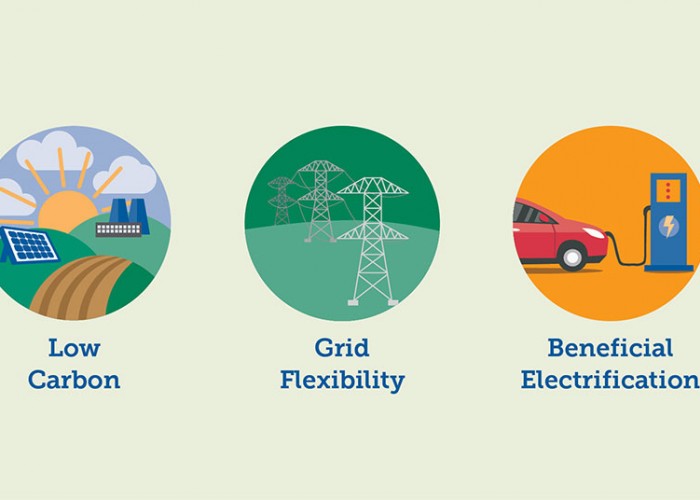Meeting Member Needs With Low-Carbon Power
Electric co-ops in North Carolina are national leaders in providing low-carbon power
By Paul G. Spruill This spring, the U.S. electric utility industry hit an interesting milestone. For the first time ever, renewable generation sources — largely hydropower, wind, solar and geothermal — generated more electricity than coal-fired power plants over the period of a month, according to data from the U.S. Energy Information Administration.
This spring, the U.S. electric utility industry hit an interesting milestone. For the first time ever, renewable generation sources — largely hydropower, wind, solar and geothermal — generated more electricity than coal-fired power plants over the period of a month, according to data from the U.S. Energy Information Administration.
Although some seasonal factors contributed — hydro generation tends to peak in the spring, and some coal plants are traditionally down for maintenance during the spring and fall — the data hints at an undeniable trend: The industry is shifting to generation that creates less carbon dioxide.
Electric cooperatives here in North Carolina are no exception to that trend. In fact, we’re national leaders when it comes to our low-carbon fuel mix. We see it as such a critical part of doing business that we’ve made it one of three core values, along with grid flexibility and beneficial electrification, to ensure a brighter energy future (see Building a Brighter Energy Future, Together).
But how will a low-carbon portfolio benefit you? How will it ultimately benefit electric co-op members and our communities? The answer comes down to three priorities: cost and reliability, meeting member needs, and doing so in an environmentally responsible way.
When you hear about low-carbon electricity in the news, it’s often framed as an endpoint or a goal. But in practice, low-carbon electricity is a path, not a destination. North Carolina’s electric cooperatives get their power from a wide range of sources, including assets owned by the North Carolina Electric Membership Corporation (NCEMC). In the 1980s, NCEMC purchased a share of the carbon-free Catawba Nuclear Station in South Carolina
— a major step on the path to a low-carbon fuel mix. NCEMC has since purchased natural gas-fired power plants, as well as power from solar and hydro resources. As a result, coal-fired generation accounts for only 6 percent of NCEMC’s fuel mix.
This diversity helps ensure reliability and affordability for our members. Our fuel mix is not dependent on any one main fuel source. It’s a sustainable solution for power generation.
Equally as important, providing low-carbon electricity is a way that electric co-ops can meet member needs and expectations. Fifty years ago, consumers valued power that was reliable, affordable and delivered safely, which all hold true today. But now many consumers also have an interest in renewable energy. As a result, several co-ops across the state, including my own, have launched community solar projects. Tideland EMC also hosts the state’s first microgrid project, on Ocracoke Island, which consists of solar production, Wi-Fi controlled thermostats and water heaters, battery storage and a traditional diesel generator. Together, these resources are available for normal electric distribution on the island when power cost savings can be achieved, as well as limited emergency use when mainland power is unavailable.
We’re finding that many businesses also value low-carbon electricity — some are even required to meet certain standards by larger, national partners. North Carolina’s electric co-ops are working with these businesses on a case-by-case basis, ensuring we can provide what they need to succeed with resources like onsite solar power, energy storage or a custom microgrid project located on or near the actual site of the business.
Lastly, meeting member needs with a low-carbon portfolio means we are delivering reliable and affordable power in an environmentally responsible way. One of the core Cooperative Principles that all electric co-ops share is a Concern for Community. Utilizing resources in a practical, sustainable way ensures the youth of today can benefit from the quality of life our communities have built over generations.
When electric co-op employees show up to work every day, we’re doing our jobs with our members in mind. Striving for a low-carbon fuel mix — with affordability and reliability as priorities — is just another way we’re working to serve you.
About the Author
Paul G. Spruill is GM & CEO for Tideland EMC in Pantego. He was seated as president of NCEMC at its 2019 annual meeting.-
More energy innovation
-
Share this story:





Comments (1)
I have stepped up to the plat in our new home construction, and spent $200,000 more than other new houses in our FH neighborhood, to create the top 1% in energy efficiency.
It would be great if Tideland could shift that pie graph more and more, in a sustainable direction as well.
BTW, nuclear is not a step forwards, it is a step backwards. Although low carbon, the environmental impacts of uranium mining, waste disposal, and the very real risks, outweigh the pluses.
Mark Johnson |
July 03, 2019 |
reply